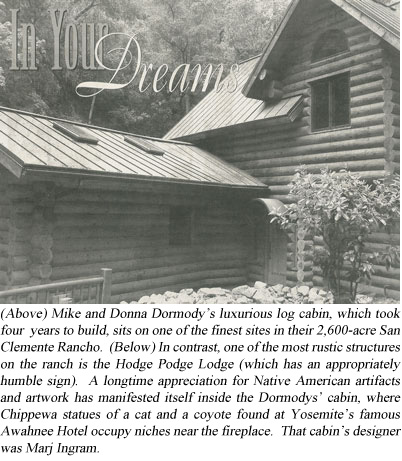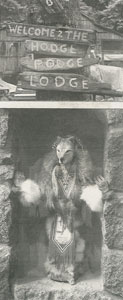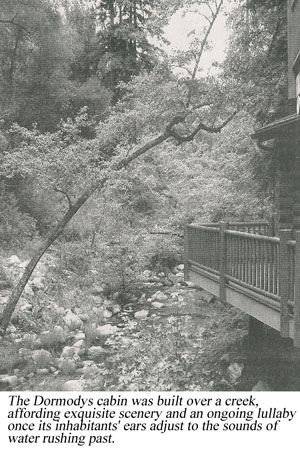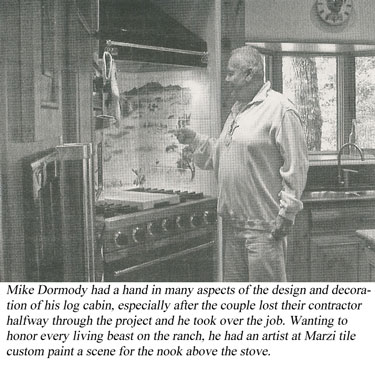The Carmel Pine Cone
In Your Dreams
Hiding out in San Clemente Rancho
By Mary Brownfield
 More
than 100 cabins, some decades old, others recently built to include
the latest amenities, are hidden in the verdant hills above Carmel
Valley. At Canyon Road about a 45-minute drive from Carmel Valley
Road – streams and hiking trails course among the spectacular flora
and fauna. More
than 100 cabins, some decades old, others recently built to include
the latest amenities, are hidden in the verdant hills above Carmel
Valley. At Canyon Road about a 45-minute drive from Carmel Valley
Road – streams and hiking trails course among the spectacular flora
and fauna.
At one time the setting for rustic camping, the rancho has evolved
into a vacationer's mountain paradise of lakes for fishing, swimming
pools, hiking trails, tennis courts, picturesque retreats – even
a stunningly set miniature golf course and a fern-lined water slide.
Some families have owned their San Clemente Rancho cabins since the
1960s, passing them to their kids, while others are newcomers who
recently discovered the magic of having such a mountain getaway.
Homesteaders
Charles and Della McFadden took advantage of the Homestead Act in
the early 1900s to acquire their ranch in the Santa Lucia mountains,
over the years cobbling together 1,800 acres on which they ran cattle,
according to its current owner, Donna Dormody. The McFaddens also
operated a hunting and fishing club on the side.
"They had worked all their lives to create a preserve and didn't
want to see it broken up," Donna said. Forty years ago, her
husband, Mike Dormody, decided to buy it.
At the time, he was hardly rich, operating an earth-moving business
clearing remote roads to places such as Stuyvesant Fish's coastal
ranch and Big Sur's Esalen. His family "thought he was nuts," Donna
said, because the land he wanted to buy was wild and largely undeveloped.
He managed to get a $1,000 loan using a Ford as collateral.
Needing to raise $10,000 in a few months, the Dormodys brought "family
after family here, and he'd say, 'There's going to be a pool there,
and a lake there,'" Donna said. Mike envisioned a venture similar
to, but nicer than, White Rock, a neighboring rustic ranch open to
hunters and fisherman, and where Mike's family had a cabin when he
was a teenager.
"There was nothing here – no pools, no lake, no nothing – it
was just glorified camping," Donna said of the McFadden Ranch.
The few structures were single-walled cabins and sheds, and the roads
were dirt.
Twenty people saw Mike's vision and bought in at $1,250 each, with
the promise he would return their cash if the venture failed. In
June 1960, the Dormodys named it San Clemente Rancho and immediately
embarked on a massive cleanup and rebuilding effort.
They began selling licenses allowing vacationers to buy cabins and
use them part time, though the Dormodys retained ownership of the
land underneath them.
In those days when county permits requirements were simple, and
long before anybody had heard of an EIR, they turned barren land
into tennis courts, a swimming pool and Trout Lake, and bulldozed
six miles of hunting roads.
Over the years they installed a ranch-wide water system, added a
kids' pool and built the bathhouse, dressing rooms, shade pavilion
and barbecue. New bridges spanned the myriad creeks and gullies,
and the Dormodys created a second lake for bass fishing. The ranch
connected to the power grid in 1974 and received phone service via
underground lines in 1986.
San Clemente Rancho also grew as the Dormodys bought more land,
the final purchase of almost 600 acres made just 10 years ago. By
the 1980s, the property included 103 cabins ranging in age and style.
Bust To Boom
For years, Donna said, "It really was a struggle," to
make a living running the ranch, and some of the characters it attracted
early on were hard partyers known to skirt the law.
"When he was starting out, Dad was really dealing with wacky
people in the '60s," said Bruce Dormody, the youngest of five
siblings who knew in high school he would someday run the business.
He bought it from his parents eight years go after working summers
on the ranch while attending school.
In the old days, there was some pretty serious vandalism and even
violence.
"In the '60s, a barbecue on the Fourth of July would end in
a fight," Bruce said. "Now I don't even have to worry
about it."
Instead, his concern is enforcing rules like no tiki torches on
cabin porches, no headfirst rides down the water slide, no dogs in
the swimming pools, no fences and no gardens, "because the animals
would just eat them."
A changing clientele that can afford the expensive newer cabins,
brisker business during the past decade and Bruce's specific touch
have made their mark on the ranch.
"It was a different feel and a different era when my parents
started it," he said.
The cabins are zoned as vacation homes that forbid year-round residency,
and harsh elements that froze the old water system and turned the
onetime dirt roads to mud kept people away during darker months.
But the installation of high-tech water system and paved roads changed
that.
"And as the houses get nicer, it's easier to come here any
time of year," Bruce added.
The county requires new cabins to meet current building codes for
fire sprinklers, earthquake resistance, etc. Bruce, who became a
licensed contractor so he could build cabins to replace old ones,
includes beautiful kitchens, fireplaces, built-in barbecues and other
niceties in the new construction.
"People aren't going to buy a $500,000, $600,000 or $700,000
cabin unless it has all the modern amenities," he explained.
But one area of latitude the county grants is their location on
the footprints of the aging structures that preceded them. Many
of the cabins are built next to – and sometimes over – the abundant
creeks and streams. Some incorporate stands of redwoods.
While cabins occasionally remain in the same family for generations,
many sell every 10 or 15 years as kids grow up and their parents
move on.
"Six to eight sell each year, but now they sell a lot faster
than they used to," said Bruce, who keeps a waiting list of
interested buyers, many of whom first visited San Clemente Rancho
as a guests. Members pay licensing and maintenance fees to Bruce,
who in turn leases the land from his parents. He and a board of
directors decide when to admit new members and set the rules.
And every once in a while, when a sales listing makes it into the
classifi8ed ads, someone will try to figure out how to live there
year-round, despite rules strictly forbidding it. (A member may
not stay in his cabin more than 45 consecutive days and must return
to his primary residence for an equal amount of time.)
"We're far away from services, and it's supposed to be a get-away
– a relaxing thing," Bruce explained. "And if a tree comes
down on the road during a storm, we'll clear it when we get to it,
not go out there in the middle of a storm because someone needs to
get the kids to school."
And the elements routinely wreak havoc. Major storms in the 1995
washed out many of the bridges the Dormodys had built in the 1960s.
"The distance from town makes you much more self-reliant –
you can't just call someone from town and say, 'Fix this,'" he
said. "You have to figure it out yourself. We have a plumbing
shed that contains everything imaginable – every tool you can think
of. But the most important tool on the ranch is the backhoe."
Tennis Courts Morph To Mini Golf
Since Bruce took over the business, he's added to the poolside fun
factor and exercised the green thumb he said Mike never had, harvesting
ferns from elsewhere on the property, planting trees and flowers,
and landscaping the entire pool area.
"Dad wasn't really into gardening," he said.
While excavating one of the fishing lakes, Bruce had trucks dump
soil near the pools so he could create a hillside for a twisting,
turning, fern-lined water slide.
"My vision was a sluice-going-through-the-jungle kind of thing,
not a slide up on a pole," he said. A year earlier, he added
a spa. A ping pong table stands incongruously among gigantic redwood
trees, and creatively placed hammocks are found in secluded stands
of trees and other idyllic spots.
Though tennis was hugely popular in the 1970s – with players lining
up to play on the Rancho's seven courts – it was no longer everybody's
favorite sport when Bruce took charge.
Some of the unused courts made way for a creatively designed and
exquisitely landscaped miniature golf course that features an Easter
Island-inspired wood carving, a waterfall cascading from a hollowed-out
tree trunk, and a wooden water tank overhead.
Some of the cracking, unused tennis courts made way for more trees,
plants, flowers and shrubs.
A few courts remain, and he plans to retain a couple but will likely
use some of the space to add a bocce court, a shuffleboard court
and other "things to keep people happy."
In the space of one former poolside court, Bruce hopes to spend
the winter constructing "a new building I call the clubhouse
but which will have everything: new changing rooms, bathrooms, a
community room, maybe with a fireplace, that will give people a place
to hang out inside if they come up during winter."
Some members are more social, while others seek solitude.
"People are friends and do barbecues at the pool together,
and whoever brings the margarita pitcher ends up sharing it with
everyone else there," he said. "Other people don't want
to do that and are happy reading their books at their cabins and
taking walks by themselves.
With the cabins, pools, catch-and-release fishing ponds, shooting
range and other activities on about 100 acres, the remainder of the
ranch features miles of hiking trails, hunting roads and some grazing
cattle.
At its busiest, such as Memorial Day weekend or
Independence Day, San Clemente Rancho will host between 200 and 300
people. But more commonly, 10 or 20 will be hanging out poolside
on a given summer day, when temperatures there can be as much as
40 degrees higher than in Carmel. Most of the cabin owners live
full time in Monterey County, though some come from other parts of
California and even other states.
"Locally, I think it's getting so much more popular because,
what are the alternatives? Drive to Tahoe, spend six hours in the
car, use tons of gas, and get up there for a traffic jam in the summer?" he
said. "Or they take a 45-minute drive up Robinson Canyon Road,
and they're here."
The Family Pads
The three Dormodys live at the rancho full time
– Mike and Donna have a large home they built at the top of a twisty
private  road on the ranch, as well as a new cabin along one of the
streams – and Bruce has a cabin closer to the action. road on the ranch, as well as a new cabin along one of the
streams – and Bruce has a cabin closer to the action.
His parents' log cabin was recently completed after four years'
labor, though Mike claims it's still not really finished.
"Knowing the ranch the way I do, I knew that this was probably
the nicest site on the whole property," he said of the creekside
location open enough to get a healthy dose of sun. "When I'm
long gone, the grandkids will be able to come up here and bring their
kids."
The two-story, three-bedroom framed cabin is sided with logs cut
in half. A deck spans the creek side of the home, with the upstairs
bedroom having a balcony of its own.
Logs line the inside of the warm, open, airy rooms as well, and
glass doors topped with arched windows look out onto the stream and
rocky hillside mere feet away.
Native American artifacts and accents – such as
the painted sinks in the bathrooms and the Chippewa statues from
Yosemite's Ahwahnee Hotel that are tucked into alcoves on each side
of the fireplace – appear throughout. Big Sure artist Greg Hawthorne
visited the Dormodys' cabin and created a three-dimensional piece
in a similar theme that hangs on the chimney.
The cabin also incorporates artifacts found just outside its doors.
"The mantelpiece is old redwood that was on the ranch," Mike
said. "We dragged it out of the creek and had it milled. And
all the rock work is from rocks on the ranch."
Artists at Marzi Tile painted an idyllic scene behind the kitchen
stove. "I wanted to have all the animals of the ranch represented," Mike
said, adding that he repeatedly returned to the artist, remembering
creatures he'd forgotten to mention earlier. Each tile was individually
painted.
"And the cabinet doors – we fooled around with those," he
said. "They're old ranch redwood that we milled and just put
those simple saw cuts at an angle." Tree forms appeared.
The Dormodys frequently have guests and family stop by the cabin
for a visit or one of Donna's wonderful meals.
"Our main house is close, but they're entirely different worlds," Mike
observed. "The biggest surprise is, at the other house, we're
all alone up there, and you don't hear anything. Spending the night
here with the sound of the creek, it's noisy if you're not used to
it."
"And people drop in on you," Donna added.
"Donna likes the cabin better than the house," confided
her husband.
Article
Copyright The Carmel Pine Cone
June 16, 2006
|